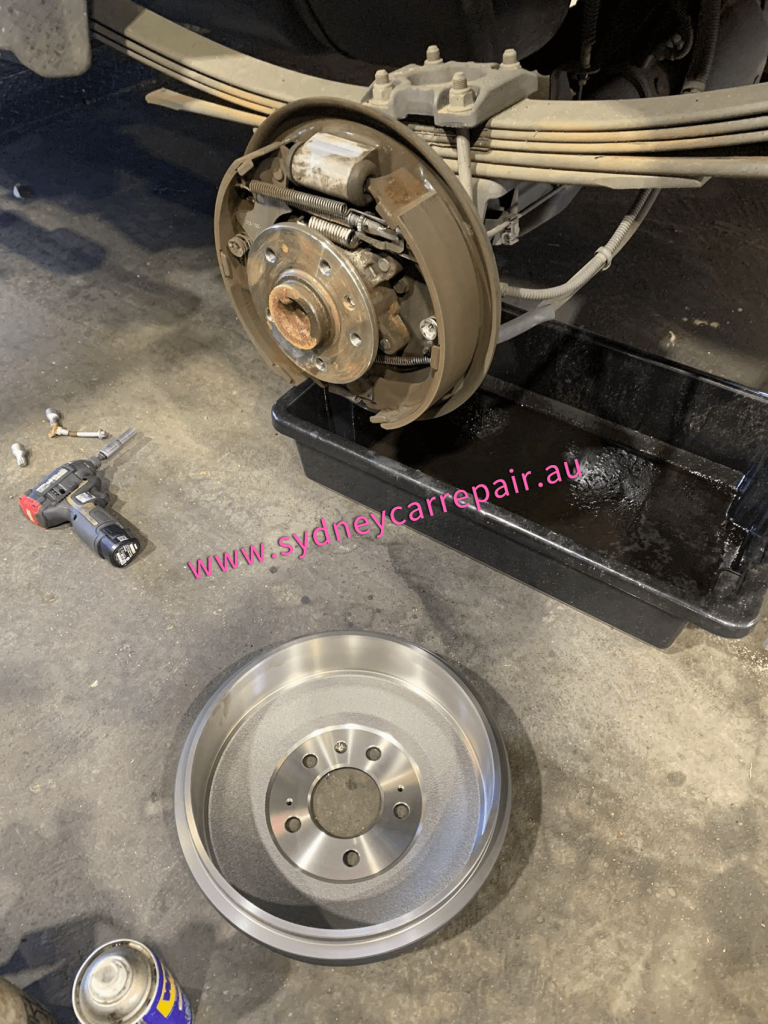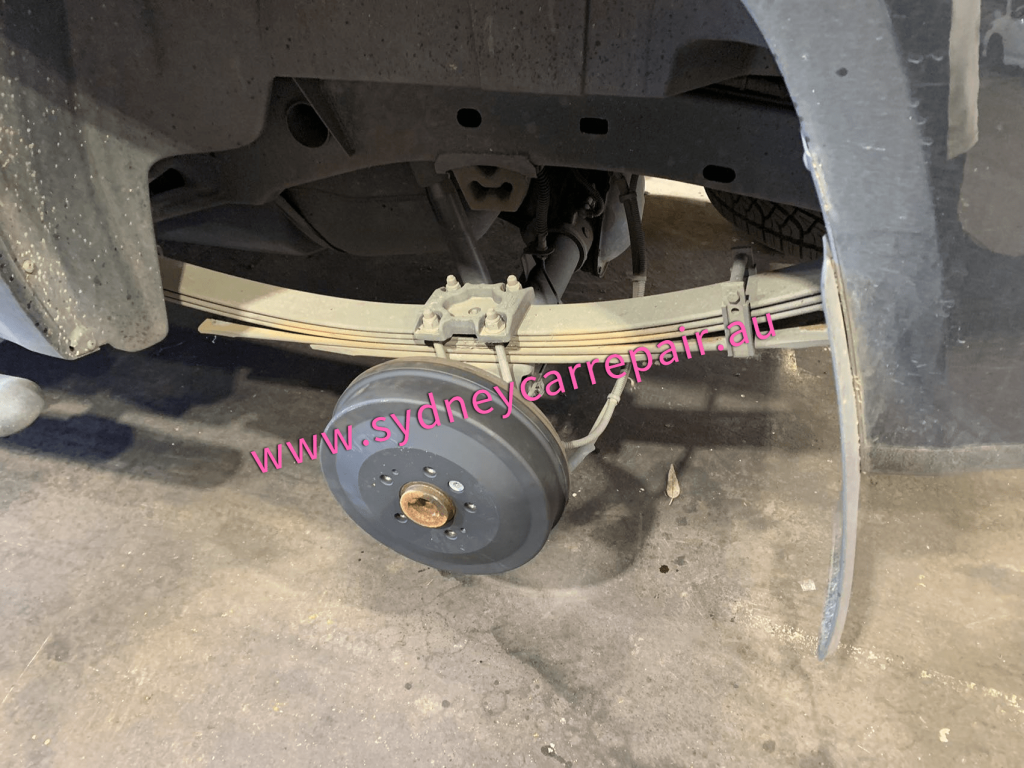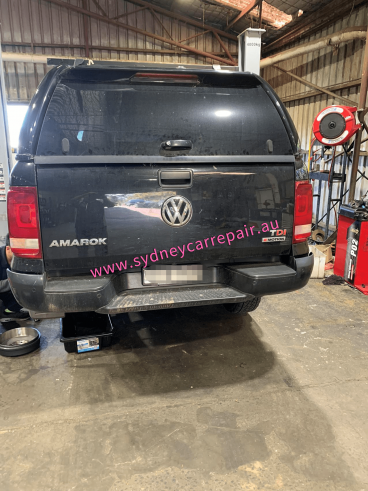What is a brake drum?
One of the oldest styles of brake systems is still in use today on some cars – brake drums. A brake drum is almost always found on the rear axle, behind each rear wheel.
Inside the brake drum, two C-shaped brake shoes skim along the smooth inner surface of the brake drum until the brake pedal is pressed.
When the brake pedal is pressed, hydraulic pressure forces the brake shoes against the inner surface of the brake drum, and the friction causes your car to decelerate.
Brake drums are made of cast iron in most cases, although in rare instances it may be cast aluminum for better heat dissipation.
Excess heat can cause brake drums to warp and become out of round.
Environmental elements such as salty air near the coast can cause corrosion, and contamination can occur if brake fluid leaks inside the brake drum.
Normal use causes wear also, and any of these conditions can require brake drum replacement.

Symptoms that you require brake drum replacement
- Brakes are unresponsive when pressed
- Shuddering feeling when brakes pressed
- Brake pedal travels further to the floor
- Grinding or scraping noise from the rear of your car

How important is this service?
When you apply your brake pedal, the brake drums rub against the brake shoes, creating friction that slows down your vehicle. If the brake drums are damaged, this friction is sporadic and inefficient, and your car will not brake as effectively. If the brake drums are worn down, they won’t be thick enough to dissipate the braking system’s heat, and the brake fluid will absorb the heat and reach a boiling point. Boiling brake fluid is less effective, and will lower the effectiveness of your brake system.

How to Replace Your Drum Brakes
- SAFETY FIRST
Replacing brakes shoes can release dusty hazardous materials into the air, especially if you are changing shoes on a car pre-1990’s with very old shoes. Wear a mask, work in a ventilated area, and make sure no one else approaches the vehicle during brake maintenance.
Prep your vehicle. Remove the wheel covers, then loosen the lug nuts. You want to do this before you lift the vehicle. Use a jack and stands to safely raise and support the vehicle. Also, the parking brake must be disengaged so the brake drum can be removed. For information on how to safely use a jack and stands, read our guide.
- REMOVE AND INSPECT THE BRAKE DRUM
To get to the brake shoes, you’ll need to remove the wheel and brake drum. The brake drum may be stuck on the axle hub. You may need to apply penetrant to get the drum off, or in worse cases, use a hammer on the face of the drum to break it loose. In really severe cases, the drum will need to be cut off, but this is a rare case. Keep in mind that some brake drums on front-wheel-drive cars have a hub with traditional cone bearings in it, and they can be removed with the spindle nut like traditional, older rotors, hub-and-drum altogether.
Remove any drum retaining screws or wheel stud retaining clips and slide the drum off. The retaining screws should be reinstalled later, but the clips may be removed permanently as these were used on the assembly line of the vehicle to keep a brake drum from falling off and bonking someone in the head. If you do see these clips, the chances are the brake shoes have never been serviced before. If the brake shoes are in tight contact with the inside of the drum, the brake adjustor screw will need to be shortened to relieve the pressure. This is accomplished by removing the small, rubber access port on the backing plate, and sticking a drum adjuster or large flathead screwdriving into the hole and turning the star wheel on the adjuster. Turning it one way will tighten the shoes against the drum. Turning it the other way will loosen the shoes. The drum should slide freely over the shoes for removal but often times will need the coaxing of a tap of a hammer, or gently pry from several pry bars.
With the brake drum off, clean and inspect it for heat stress cracks, hot spots, or deep gouging. Measure the inside diameter of the drum with a brake micrometer. The diameter specification should be stamped visibly on the outside of the drum. A brake drum with heat cracks, gouges severe hot spots, or that exceeds the specification limit should be discarded and replaced with a new drum. If you are within spec, these drums can be machined or “turned” at a machine shop.
- REMOVE THE BRAKE SHOES AND HARDWARE
The brake shoes are held in place by hold down and return springs. Specialty brake tools may be needed to make removal and reinstallation easier. The return springs have extreme tension. Use caution while removing and installing them.
It’s a great idea to either use a specific repair manual for your vehicle, or take detailed pictures of exactly how the springs go on, their orientation, and how the self-adjusting cables and springs go on. Everything has a specific way and orientation, so make sure you have it right! Another good practice is to do one side at a time, and leave the other in tact as a reference for how the items all work and go on.
- INSPECT AND CLEAN THE REMAINING BRAKE COMPONENTS
With the shoes and related system components removed, clean and inspect each item. It’s always a good idea to install new brake springs. Wheel cylinder replacement is also recommended if you see any wetness around the rubber ends, or the rubber seals are cracked. A wheel cylinder may develop a leak after the brake job is completed, so if you choose to replace them, now is the time to do it. If a wheel cylinder fails, the brake system fluid will become low and soak the brake components. Replacement of these items will ensure smooth, reliable braking performance.
Clean and inspect the parking brake components and the self-adjustor assembly. The adjustment screw will need to be cleaned, and lubricated with anti-seize. You will notice several small raised portions of the backing plate where the brake shoes pivot and rest against the backing plate. Clean these areas with a wire brush, and apply brake grease or anti-seize to these areas. Before doing this, if outside, you can chose to clean the entire backing plate with degreaser and a hose to remove old brake dust.
- RE-INSTALL THE BRAKE SHOES AND COMPONENTS
Now it’s time to reassemble the brake parts.
First, lay out your brake shoes. You will notice that on the brake friction material, two of the shoes have a shorter piece of friction material and/or are thinner. Two of them have a longer piece of material and/or are thicker. This is what is known as a PRIMARY and SECONDARY shoe. The SECONDARY brake shoe, or the one that is thinner with less length of material always is the leading shoe, or the shoe pointing towards the front of the vehicle. The PRIMARY shoe is the tailing shoe, going towards the rear. Do not mix these up! This is one of the most common mistakes made when replacing brake shoes.
Start by installing the brake shoes with their hold-down springs, and the bottom adjuster wheel, noting it’s correct orientation. Now, you can begin to install the springs and self-adjusting hardware, making sure to follow your manual or photos carefully. Be very careful with tensioning and installing new springs, as many can be very difficult to re-install.
After assembly, you will need access to the brake adjustor star wheel when the brake drum is installed. It can be accessed through the backing plate or brake drum, depending on your vehicle – the same hole used to adjust the shoes when you removed them.
- INSTALL THE BRAKE DRUM
Make sure the brake shoes are clean and free of contamination. Slide the new or re-machined drum over the wheel studs and shoes onto the hub. If the drum won’t fit, adjust the star wheel to collapse the shoes farther in, so the drum slides over. If you replaced the wheel cylinders, bleed them now.
Now, use a brake adjusting tool or large flathead screwdriver now to adjust the brakes. To do so, reinstall the wheel and tire with several lug nuts.
Now, spin the wheel slowly. You will be adjusting the star wheel through the backing plate until you just feel the brake shoes lightly contact the brake drum. Do not overtighten. You should barely hear, and feel the shoes contact the drum, and there should be a very small amount of resistance over the wheel free-spinning.
Once you’ve accomplished this, your wheel/tire is ready for final lug nut torque. Once both sides are done, check brake fluid in the master cylinder, and prepare for a test drive.
Re-install the wheels and properly torque the wheel lug nuts. Reattach the wheel covers. Re-check the brake fluid level in the brake master cylinder. Prepare for test drive.
- TEST DRIVE
Once behind the wheel, press the brake pedal and make sure it feels normal. It should be firm with some initial travel. If the brake pedal seems to low, the brake shoes may need more adjustment or additional bleeding. Make sure the brake pedal travel is normal before test driving. Apply the brake pedal lightly during the initial test drive. It should be firm and smooth. The brake shoes will eventually seat. This will happen over time. Just make sure the brake pedal is firm and there are no strange noises or brake fluid leaks. Don’t forget to check your brake lights and all your lights.
Once you’ve had a few miles testing the brake shoes, it’s a good idea to lift the car again, free spin the wheels and check for proper adjustment. From here, your self-adjusters should pick up and begin properly adjusting the brakes. Self-adjusters work when you apply brake pressure in reverse gear. As the brake shoes pivot against the drum, the adjusting pawl clicks the star wheel, and adjusts the shoes properly. If you re-installed everything correctly, these adjusters should properly work. Brake shoes require a little more attention to detail than brake pads, which are generally just “change and go”.
Looking for Car Repair and Car Inspection in Sydney? Give us (Sydney Car Repair) a call today to get FREE QUOTE.
All of our car servicing and car repair jobs are carried out by licenced vehicle technicians with years of extensive experience across all popular and luxury makes and models.
Our Address: 71 Atkins Road, Ermington, NSW 2115

Turn on Your Camera and Scan Me to add our contact detail to your phone.
If you are live in Eastwood, Carlingford, Ermington, Auburn , Burwood, Macquarie Park, Parramatta, Chatswood and you need to have your car service and repair near me, car maintenance near me, car mechanic near me you are welcome to visit our car mechanic shop to get it done. We do car servicing and car repair job for people for the Eastwood, Carlingford, Epping, Ryde, Ermington, Auburn, Burwood, Macquarie Park, Parramatta, Chatswood and all the rest of Sydney, Australia. Mechanic near me car, repair near me, vehicle repair near me. Tyre repair near me, tyre replacement near me.
If you need mechanic near me or car repair or used car inspection near me, we can repair most of the following car’s and repair for you in sydney: TOYOTA, HONDA, Mazda, BMW, BENZ, MINI, NISSAN, Mitsubishi, Subaru, Audi, Volkswagen, Hyundai, Ford, Holden, JEEP, Kia, Tesla and many more。


